Abstract
Using fura-2-acetoxymethyl ester (AM) fluorescence imaging and patch clamp techniques, we found that endothelin-1 (ET-1) significantly elevated the intracellular calcium level ([Ca2+]i) in a dose-dependent manner and activated the L-type Ca2+ channel in cardiomyocytes isolated from rats. The effect of ET-1 on [Ca2+]i elevation was abolished in the presence of the ETA receptor blocker BQ123, but was not affected by the ETB receptor blocker BQ788. ET-1-induced an increase in [Ca2+]i, which was inhibited 46.7% by pretreatment with a high concentration of ryanodine (10 μmol/L), a blocker of the ryanodine receptor. The ET-1-induced [Ca2+]i increase was also inhibited by the inhibitors of protein kinase A (PKA), protein kinase C (PKC) and angiotensin type 1 receptor (AT1 receptor). We found that ET-1 induced an enhancement of the amplitude of the whole cell L-type Ca2+ channel current and an increase of open-state probability (NPo) of an L-type single Ca2+ channel. BQ123 completely blocked the ET-1-induced increase in calcium channel open-state probability. In this study we demonstrated that ET-1 regulates calcium overload through a series of mechanisms that include L-type Ca2+ channel activation and Ca2+-induced Ca2+ release (CICR). ETA receptors, PKC, PKA and AT1 receptors may also contribute to this pathway.
Similar content being viewed by others
References
Yanagisawa M, Kurihara H, Kimura S. et al. A novel potent vasoconstrictor peptide produced by vascular endothelial cells. Nature, 1988, 332: 411–415 2451132, 10.1038/332411a0, 1:CAS:528:DyaL1cXlsVaks78%3D
Tang J. Endocrine function of circulation system (in Chinese). Beijing: Chinese Academy of Medical Sciences & Peking Union Medical College Press, 1989.
Wainwright C L, McCabe C, Kane K A. Endothelin and the ischaemic heart. Curr Vasc Pharmacol, 2005, 3(4): 333–341 16248776, 10.2174/157016105774329417, 1:CAS:528:DC%2BD2MXhtVaht7jK
Suzuki Y J, Nagase H, Nie K, et al. Redox control of growth factor signaling: recent advances in cardiovascular medicine. Antioxid Redox Signal, 2005, 7(5–6): 829–834 15890031, 10.1089/ars.2005.7.829, 1:CAS:528:DC%2BD2MXktVWitL4%3D
Moe G W, Rouleau J L, Nguyen Q T, et al. Role of endothelins in congestive heart failure. Can J Physiol Pharmacol, 2003, 81(6): 588–597 12839270, 10.1139/y03-011, 1:CAS:528:DC%2BD3sXkvV2kt7o%3D
Angerio A D. The role of endothelin in heart failure. Crit Care Nurs Q, 2005, 28(4): 355–359 16239825
Stewart D J, Kubac G, Costello K B, et al. Increased plasma endothelin-1 in the early hours of acute myocardial infarction. J AM Coll Cardial, 1991, 18: 38–43 1:STN:280:DyaK3M3mvVCitQ%3D%3D, 10.1016/S0735-1097(10)80214-1
Liu G X, Wang H, Ou D M. Endothelin-1, an important mitogen of smooth musclecells of spontaneously hypertensive rats. Chin Med J, 2002, 115: 750–752 12133549, 1:CAS:528:DC%2BD38XltVSltr0%3D
Ammarguellat F, Larouche I, Schiffrin E L, Myocardial fibrosis in DOCA-salt hypertensive rats: effect of endothelin ET (A) receptor antagonism. Circulation, 2001, 103: 319–324 11208696, 1:CAS:528:DC%2BD3MXhtFahsrY%3D
Ammarguellat F Z, Gannon P O, Amiri F, et al. Fibrosis, matrix metalloproteinases, and inflammation in the heart of DOCA-salt hypertensive rats: role of ET(A) receptors. Hypertension, 2002, 39: 679–684 11882630, 10.1161/hy0202.103481, 1:CAS:528:DC%2BD38Xhs1Wqt7g%3D
Kuhlmann C R, Most A K, Li F, et al. Endothelin-1-induced proliferation of human endothelial cells depends on activation of K+ channels and Ca2+ influx. Acta Physiol Scand 2005, 183: 161–169 15676057, 10.1111/j.1365-201X.2004.01378.x, 1:CAS:528:DC%2BD2MXhtlOqtro%3D
Mohacsi A, Magyar J, Tamas B, et al. Effects of endothelins on cardiac and vascular cells: new therapeutic target for the future? Curr Vasc Pharmacol, 2004, 2(1): 53–63 15320833, 10.2174/1570161043476528, 1:CAS:528:DC%2BD2cXpvVek
Cleemann L, Morad M. Role of Ca2+ channel in cardiac excitation-contraction coupling in the rat: evidence from Ca2+ transients and contraction. J Physiol, 1991, 432: 283–312 1653321, 1:STN:280:DyaK3MzlvFWlug%3D%3D
He J Q, Pi Y, Walker J W, et al. Endothelin-1 and photoreleased diacylglycerol increase L-type Ca2+ current by activation of protein kinase C in rat ventricular myocytes. J Physiol, 2000, 524 Pt 3: 807–820 10.1111/j.1469-7793.2000.00807.x
Boixel C, Dinanian S, Lang-Lazdunski L, et al. Characterization of effects of endothelin-1 on the L-type Ca2+ current in human atrial myocytes. Am J Physiol Heart Circ Physiol, 2001, 281(2): H764–H773 11454581, 1:CAS:528:DC%2BD3MXmtVClsb4%3D
Lauer M R, Gunn M D, Clusin W T. Endothelin activates voltage-dependent Ca2+ current by a G protein-dependent mechanism in rabbit cardiac myocytes. J Physiol, 1992, 448: 729–747 1593486, 1:CAS:528:DyaK38XhsVCks7s%3D
Ono K, Eto K, Sakamoto A, et al. Negative chronotropic effect of endothelin 1 mediated through ETA receptors in guinea pig atria. Circ Res, 1995, 76(2): 284–292 7834840, 1:CAS:528:DyaK2MXkt1Kgtr4%3D
Cheng T H, Chang C Y, Wei J, et al. Effects of endothelin 1 on calcium and sodium currents in isolated human cardiac myocytes. Can J Physiol Pharmacol, 1995, 73(12): 1774–1783 8834492, 1:CAS:528:DyaK28XhtFCit78%3D
Tohse N, Hattori Y, Nakaya H, et al. Inability of endothelin to increase Ca2+ current in guinea-pig heart cells. Br J Pharmacol, 1990, 99(3): 437–438 2158839, 1:CAS:528:DyaK3cXhsFamsLw%3D
Ko E A, Park W S, Ko J H, et al. Endothelin-1 increases intracellular Ca2+ in rabbit pulmonary artery smooth muscle cells through phospholipase C. Am J Physiol Heart Circ Physiol, 2005, 289(4): H1551–H1559 16162868, 10.1152/ajpheart.00131.2005, 1:CAS:528:DC%2BD2MXhtFensLnO
Minowa T, Miwa S, Kobayashi S, et al. Inhibitory effect of nitrovasodilators and cyclic GMP on ET-1-activated Ca2+-permeable nonselective cation channel in rat aortic smooth muscle cells. Br J Pharmacol, 1997, 120: 1536–1544 9113376, 10.1038/sj.bjp.0701059, 1:CAS:528:DyaK2sXjtVGrs7Y%3D
Zima A V, Blatter L A. Inositol-1, 4, 5-trisphosphate-dependent Ca(2+) signalling in cat atrial excitation-contraction coupling and arrhythmias. J Physiol, 2004, 555: 607–615 14754996, 10.1113/jphysiol.2003.058529, 1:CAS:528:DC%2BD2cXivFCmsbg%3D
Xu Y, Sandirasegarane L, Gopalakrishnan V. Protein kinase C inhibitors enhance endothelin-1 and attenuate vasopressin and angio tensin II evoked [Ca2+]i elevation in the rat cardiomyocyte. Br J Pharmacol, 1993, 108(1): 6–8 8428214, 1:CAS:528:DyaK3sXnsVemsw%3D%3D
Chu L, Takahashi R, Norota I, et al. Signal Transduction and Ca2+ Signaling in contractile regulation induced by crosstalk between endothelin-1 and norepinephrine in dog ventricular myocardium. Circ Res, 2003, 92(9): 1024–1032 12690035, 10.1161/01.RES.0000070595.10196.CF, 1:CAS:528:DC%2BD3sXjsVGqtL4%3D
Moreau P, d’Uscio L V, Shaw S, et al. Angiotensin II increases tissue endothelin and induces vascular hypertrophy: reversal by ET(A)-receptor blocker, Circulation, 1997, 96(5): 1593–1597 9315552, 1:CAS:528:DyaK2sXmtFeisLs%3D
Rajagopalan S, Laursen J B, Borthayre A, et al. Role for endothelin-1 in ang II-mediated hypertension, Hypertension, 1997, 30(1 Pt 1): 29–34 9231817, 1:CAS:528:DyaK2sXlt1Cku70%3D
d’Uscio L V, Moreau P, Shaw S, et al. Effects of chronic ETA-receptor blockade in ang II-induced hypertension. Hypertension, 1997, 29(1 Pt 2): 435–441 9039139
Bkaily G, Wang S, Bui M, et al. ET-1 stimulates Ca2+ current in cadiac cells, J Candiovasc Pharmacol, 1995, 26: 293–296
Furukawa T, Ito H, Nitta J, et al. Endothelin-1 enhances calcium entry through T-type calcium channels in cultured neonatal rat ventricular myocytes. Cir Res, 1992, 71: 1242–1253 1:CAS:528:DyaK38Xmt1Ojsbc%3D
Nowycky M C, Fox A P, Tsien R W. Three types of neurohal calcium channel with different calcium agonist sensitivity. Nature, 1985, 316: 440–443 2410796, 10.1038/316440a0, 1:CAS:528:DyaL2MXltVamsrY%3D
Rosenberg R L, Hess P, Tsien R W. Cardiac calcium channels in planar lipid bilayers. L-type channels and calcium-permeable channels open at negative membarane potentials. J Gen Physiol, 1988, 92: 27–54 2844956, 10.1085/jgp.92.1.27, 1:CAS:528:DyaL1MXktVentbY%3D
Coulombe A, Lefevre I A, Baro I, et al. Barium-and calcium-permeable channels open at negative membrane potentials in rat ventricular myocytes. J Membr Biol, 1989, 111: 57–67 2478710, 10.1007/BF01869209, 1:STN:280:DyaK3c%2FktVKrsg%3D%3D
Reuter H, Stevens C F, Tsien R W, et al. Properties of single calcium channels in cardiac cell culture. Nature, 1982, 297: 501–504 6283360, 10.1038/297501a0, 1:STN:280:DyaL383hvF2qtg%3D%3D
Nilius B, Hess P, Lansman J B, et al. A novel type of cardiac calcium channel in ventricular cell. Nature, 1985, 316: 443–446 2410797, 10.1038/316443a0, 1:CAS:528:DyaL2MXlt1SrsLc%3D
Bean B P. Two kinds of calcium channels in canine atrial cells differences in kinetics, selectivity, and pharmacology. J Gen Physiol, 1985, 86: 1–30 2411846, 10.1085/jgp.86.1.1, 1:CAS:528:DyaL2MXkvVGrsro%3D
Zhou Z, Lipsius S L. T-type Calcium current in latent pacemaker cells isolated from cat right atrium. J Mol Cell Cardiol, 1994, 26: 1211–1219 7815463, 10.1006/jmcc.1994.1139, 1:CAS:528:DyaK2cXmt1Ojurw%3D
Izumi T, Kihara Y, Sarai N, et al. Reinduction of T-type calcium channels by endothelin-1 in failing hearts in vivo and in adult rat ventricular myocytes in vitro. Circulation, 2003, 108: 2530–2535 14581409, 10.1161/01.CIR.0000096484.03318.AB, 1:CAS:528:DC%2BD3sXovVeku7o%3D
Habuchi Y, Tanaka H, Furukawa T, et al. Endothelin enhances delayed potassium current via phospholipase C in guinea pig ventricular myocytes. Am J Physiol, 1992, 262: H345–H354 1539693, 1:CAS:528:DyaK38XhvVymtbs%3D
Lu T, Huang Y, Jiang W. The electrophysiologic effects of endothelin a patch clamp study in guinea pig ventricular myocytes. Chin Med J, 1995, 108: 618–625 7587496, 1:CAS:528:DyaK28XhtFylt7w%3D
Banyasz T, Magyar J, Kortvely A, et al. Different effects of endothelin-1 on calcium and potassium currents in canine ventricular cells. Naunyn Schmiedebergs Arch Pharmacol, 2001, 363(4): 383–390 11330331, 10.1007/s002100000379, 1:CAS:528:DC%2BD3MXhslWmurY%3D
Magyar J, Iost N, Kortvely A, et al. Effects of endothelin-1 on calcium and potassium currents in undiseased human ventricular myocytes. Pflugers Arch, 2000, 441(1): 144–149 11205054, 10.1007/s004240000400, 1:CAS:528:DC%2BD3cXotVeltbo%3D
Boixel C, Dinanian S, Lang-Lazdunski L, et al. Characterization of effects of endothelin-1 on the L-type Ca2+ current in human atrial myocytes. Am J Physiol Heart Circ Physiol, 2001, 281(2): H764–H773 11454581, 1:CAS:528:DC%2BD3MXmtVClsb4%3D
Kedzierski R M, Yanagisawa M. Endothelin system: the double-edged sword in health and disease. Annu Rev Pharmacol Toxicol, 2001, 41: 851–876 11264479, 10.1146/annurev.pharmtox.41.1.851, 1:CAS:528:DC%2BD3MXjsVaqtL0%3D
Author information
Authors and Affiliations
Corresponding author
Additional information
Supported by the National Natural Science Foundation of China (Grant No. 200830870910).
Rights and permissions
About this article
Cite this article
Zeng, Q., Li, X., Zhong, G. et al. Endothelin-1 induces intracellular [Ca2+] increase via Ca2+ influx through the L-type Ca2+ channel, Ca2+-induced Ca2+ release and a pathway involving ETA receptors, PKC, PKA and AT1 receptors in cardiomyocytes. SCI CHINA SER C 52, 360–370 (2009). https://doi.org/10.1007/s11427-009-0046-z
Received:
Accepted:
Published:
Issue Date:
DOI: https://doi.org/10.1007/s11427-009-0046-z




